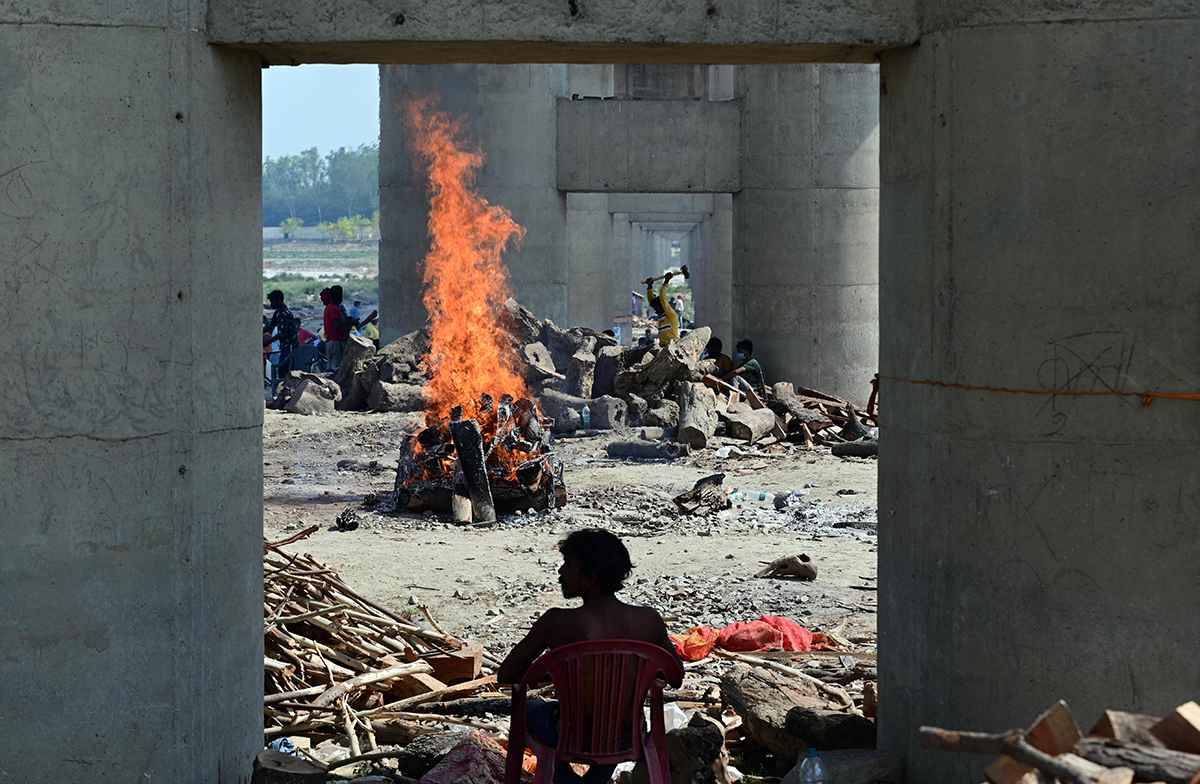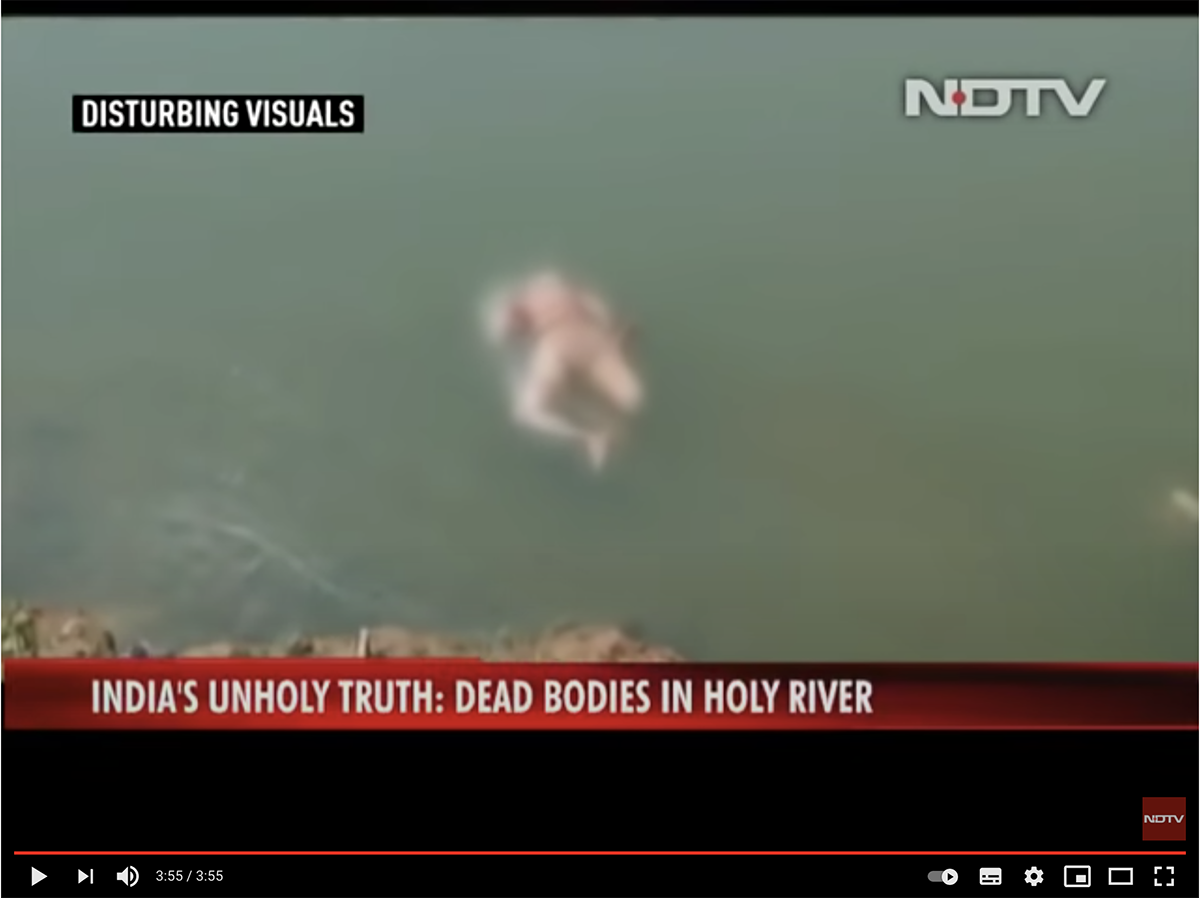The country, filled with the smoke of its burning pyres, marches blindly towards apocalypse

Last year, when COVID-19 cases were first reported in India, the government immediately declared a complete lockdown throughout the country. People in need of commuting from one place to another had to obtain e-passes, or permission to move around, as the administration put in place stringent travel rules. Many could not even bid final farewells to their loved ones due to curtailed mobility. Restrictions were in place to allow only 20 guests at marriages. Educational institutions, places of worship, cinema halls, malls and bars were closed. The country was reporting only a few thousand new cases per day then.
Today (5 May 2021) India reported a record surge in new cases, to over 400,000, by far the largest single-day count in any country so far. Experts say this will peak during mid-May, with 800,000–1,000,000 new cases per day. India’s healthcare system is already on the brink of collapse due to a shortage of medicines, oxygen supply, ventilators, hospital beds and intensive care units. Yet Prime Minister Narendra Modi has declined an offer from the United Nations for help in procuring medical supplies, manufacturing a blanket lie that India has a robust system to deal with the situation.
Ashok Amrohi, former Indian ambassador to many countries, passed away early in the morning of 27 April after waiting for a bed in the parking lot of Gurgaon’s Medanta Hospital for nearly five hours. If this is the state of a former Indian Foreign Service diplomat, imagine the plight of the poor. And it’s not just Gurgaon; the tragic situation is the order of the day all across India. With hospitals buckling under this record surge, you can forget about admitting patients, they are not even allowed to enter the hospitals and are treating themselves at home. But how to procure oxygen for those enduring at home, especially when there is a critical shortage across the country? The black-market price of an oxygen cylinder is climbing past Rs.40,000, and a single vial of Remdisivir, an antiviral medicine, is going for up to Rs.30,000. And even then: you may be willing to pay the price, but someone could still outbid you. Yet, addressing a virtual summit of the World Economic Forum on 28 January, the prime minister boasted to global leaders that his country had saved humanity from a big disaster by effectively containing the virus.
The predicament of vaccination is a heartbreaking story by itself. Although several world-class Indian pharmaceutical companies were capable of producing COVID-19 vaccinations, the government approved only two companies to manufacture them. Now, this blinkered decision has hampered the vaccination programme due to acute production shortfall. As only government hospitals administer the vaccine, people are cutting the vaccine lines to get it by hook or crook. Recently, I was appalled to see an unruly crowd in front of a government healthcare centre for COVID vaccination and left the place immediately fearing I might catch the virus there.
Of the 1.37 billion people in India, only 13 million have received one dose and only 2.14 million two; now the government stands emptyhanded because of vaccine shortage. With not enough stock to vaccinate even the population aged forty-five years and above, the government has irresponsibly announced that everyone above the age of eighteen will be eligible to get the vaccine from 1 May!
This is what Muthu Krishnan, a Madurai-based activist and writer, wrote on his Facebook page: ‘When the whole country is reeling under perilously low oxygen supply during the pandemic, Modi is sitting in his air-conditioned VVIP aircraft, flaunting his new colourful turban for a selfie opportunity. When desperate relatives of Delhi Covid patients are pleading for a bed and oxygen outside the hospitals, the Emperor is busy trying to match his turban with the shades on his walls. When crematoriums are overwhelmed giving way to makeshift funeral pyres burning through the night, when there is not enough wood to burn the deceased, and when rows of dead bodies are laying on the ground unwrapped due to scarcity of white cloth, the Emperor seems to be in conversation with an Italian designer to choose the turban to wear for the first session of Parliament.’

Why did the prime minister or his sycophants not prepare for a repeat of last year’s situation? Why did they not proactively study how other nations have readied themselves for another surge during the pandemic? Today, as COVID deaths surge and crematoriums run out of space, the dead are being buried on roads in northern India. With more than a year at their disposal since the pandemic began, the government’s preparedness for maintaining oxygen supplies has come under scathing criticism. Precious lives are lost because of lack of planning on the part of the government.
Schools and colleges have remained closed for more than a year now. In the last 200 years of Indian history, educational institutions have never remained closed for such a prolonged period. Of course, it was the right decision considering the situation at that time. But why did the central and state governments open malls and movie theatres when the educational institutions are still closed? Thiruvalluvar classifies human life into three categories: Aram – dharma/virtue; Porul – wealth/goods; and Inbam – pleasure/love. But Tamil society today has given a completely new, postmodern and material definition to them: Aram – temples; Porul – shopping malls, elections (materialistic gain); and Inbam – cinema.
When COVID was rampaging through India and turning it into one big burial ground at the beginning of April, the central government gave the go-ahead for the Kumbh Mela ‘show’ in Haridwar. On 12 April alone, more than two million pilgrims took a holy dip in the Ganges in Haridwar. It was a ‘superspreader’ event, and it looked utterly absurd to the rest of the world. If, on the one hand, the government’s handling of the situation is atrocious, people’s behaviour has to be condemned equally, if not more. Hindu scriptures call for worshipping gods at home and do not even mandate visiting temples. That is why every Indian home has an altar or a pooja room designated for worship.
Despite restrictions, even with a limited number of guests, weddings are the next big reason for the virus spread. My close friends and fellow writers, with no exceptions, attended weddings and are now unable to find hospital beds, reeling from infections at home. I have lost a few of my dear friends to COVID. One of them was just forty years old. I advised him against attending the marriage. He insisted on attending, saying that it was his close friend. I was also close friends with the host. I urged him to postpone the marriage. He feared, “It is my close friend’s daughter’s wedding. The groom’s family will not accept that the wedding be deferred to a later date. If the wedding is cancelled, he will never be able to find another groom for his daughter.” The irony is all of them were educated and belonged to the upper class. As far as I know, three people who attended the wedding have died of COVID (including my friend). At least 70 have contracted the virus. Does it not make the wedding host a criminal?
If people were foolish enough to ignore the virus, the government went one step further by conducting elections as the nation edged ever closer to doom. Elections in India are nothing but a political Kumbh Mela. Thousands gathered for election rallies and public rallies – another superspreader.
An entire nation is oblivious to the apocalypse they are marching towards. I am not sure how many more tens of thousands will have submitted themselves in death to the virus by the time you read this article. The official current death count stands at 226,000. But the real count, I am afraid, is at least 20 times more. It is nothing but carnage. Yet the prime minister is busy matching his sherwani, turban and sandals and posting selfies. His clown subjects may not care about anything and go about their lives in his footsteps, as if nothing has happened. If you don’t believe my words, let me tell you about a call I received in the middle of all this and as I was typing this article. It was from a celebrated movie director. He wanted to know if I would be interested in acting in his latest movie!
India – there really is no place like it.
Statistical data from Madurai-based activist and writer Muthu Krishnan
Translated from the Tamil by Srividhya Subash